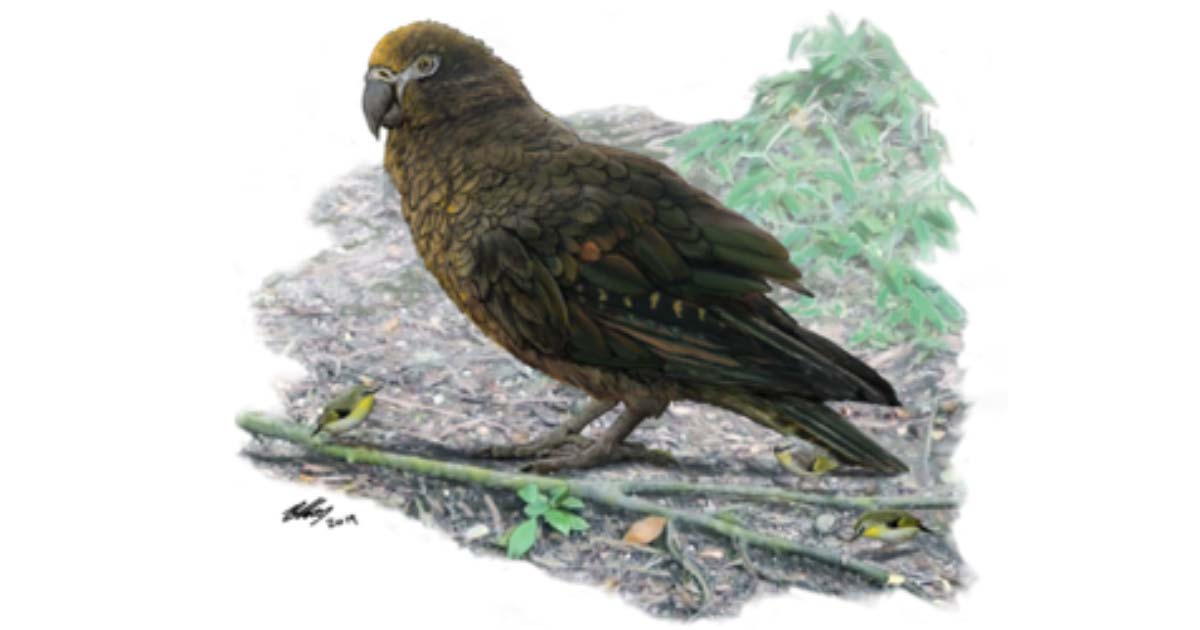3 Foot Tall Parrot Species Discovered On New Zealand, Island Of Feathered Giants
Scientists have uncovered fossilized leg bones from a gigantic parrot that once inhabited Central Otago on the South Island of New Zealand.
The St. Bathans fauna comprises a rich suite of fossilized prehistoric animals and birds from the late Early Miocene (Altonian) period, with an age range of 19 - 16 million years ago that has yielded fossils of other giant birds like for example; a giant eagle, moas, bats and other species of parrot. According to a new research paper published in Biology Letters, the “15-pound, 3-foot-tall parrot’s” partial tibiotars (middle of three leg bones) were discovered in 2008 in rock that hadn’t seen water for almost 20 million years, therefore it could be described as ‘polyunsaturated' (forgive me please).
Avian evolution produced a wide range of giant flightless birds and Trevor Worthy, associate professor at Flinders University in Australia, who leads research on the St Bathans’ fauna, told Gizmodo “Parrots are clever, able to solve problems.” Now, just in case you don’t know, a speaking-parrot is different from a spelling-bee and these ancient birds’ “problems” were how to constantly find food and sex. Speaking about this giant parrot, Worthy said being “restricted mainly to the ground” it likely fed on “berries and seeds of the abundant fruit that existed in the forest it lived in.”

Main fossil leg bone of the Heracles, above, with kakapo leg bones (partial femur and tibiotarsus) at the Flinders Palaeontology Laboratory. (Flinders University)
Even Scientists Need A Little Luck
The archaeologists in New Zealand admit that they hadn’t actually established a gap in the evolutionary bird chain which led them to seek out this new giant parrot, and they just happened upon the fossil by total chance, so it really was an unplanned parrot-hood (forgive me again). And when branding the newly discovered creature the scientists brought together the unexpected nature of the discovery and the colossal size of the giant bird in the name ‘Heracles inexpectatus’, which according to a Newsweek article follows in their tradition of naming new bird species after “figures of Greek mythology.”
Some readers will no doubt be joining me in shaking their heads while reading about this team of supposedly ‘hard’ scientists choosing a name from something so unscientific as mythology. There are no good excuses for this blatant blending of the imperial with the conceptual and a much simpler and far more academically appropriate name to describe this ‘lost parrot’ would have been ‘Polygon’.
- First Giant Bird Found In Europe Lived Alongside Early Humans
- Humans were Hunting the Largest Bird in the World on Madagascar 10,500 Years Ago
- Ancient Raptor Captors Weren’t Thugs: Neanderthals Caught Eagles and Treasured Their Talons

Graphic showing the Heracles inexpectatus silhouette next to an average height woman and common magpie. (Image: Professor Paul Scofield, Canterbury Museum, Christchurch / Flinders University)
The Cost Of Discovery
Martin Stervander, postdoctoral fellow at the University of Oregon, told Gizmodo in an email, “These authors are experts and systematically account for the shape of ridges, crests, and depressions on the bones”. Assembling and comparing the similarities and differences of the new bird bones with other major bird lineages in other museum collections is a costly affair, once all the lunches, fuel and wages are added up, but this aspect is not even being considered by the scientists who continue to just put everything ‘on the bill’.

Tibiotarsi of Heracles inexpectatus gen. et sp. nov., left, holotype (a,b,f) NMNZ S.51083 and right, paratype (g), compared to (d,e) left tibiotarsus of Strigops habroptila (Canterbury Museum Av45277), in craniolateral (a) and cranial (b–g) views. (c) Silhouettes of a human and Heracles for scale. Scale bars are 20 mm. Abbreviations: ccl, crista cnemialis lateralis; cl, condylus lateralis; cm, condylus medialis; dtl, distal insertion scar for transverse ligament; fc, fibular crest; lfr, lateral scar for fibular retinaculum; lic, linea intermuscularis cranialis; mfr, mediocranial scar for fibular retinaculum; pons, pons supratendineus; ptl, proximal insertion scar for transverse ligament; se, sulcus extensorius; sf, sulcus m. fibularis; trf, tuberculum retinaculi m. fibularis. Human silhouette from PhyloPic by T. M. Keesey.
A 2014 ASSS Science article informs that “for millions of years, nine species of large, flightless birds known as moas ( Dinornithiformes) thrived in New Zealand and about 600 years ago, they abruptly went extinct.” The two largest species of Moa, Dinornis robustus and Dinornis novaezelandiae, reached about 3.6 m (12 ft) in height with neck outstretched, and weighed about 230 kg (510 lb). Their die-off coincided with the arrival of the first humans in the late 13th century, but there are some scientists who claim disease and volcanic eruptions were already taking care of that.
And while the academic community debate as to what brought moas and this new giant parrot to extinction, maybe we should look towards the name ‘Polynesia’, which suggests ‘memory loss’ in both species. Or it might have been the case that a lowering of their immune systems after a flood ravaged the island caused an epidemic of ‘Chirpes’, which might or might not have been an ancient ‘canarial disease with no tweetment.’ (Better just stop now.)
Top image: Reconstruction of the parrot Heracles, whose giant bird bones show it dwarfed 8cm high Kuiornis – small New Zealand wrens scuttling about on the forest floor. Source: Brian Choo / Flinders University
Source: ‘Evidence for a giant parrot from the early Miocene of New Zealand’ (2019) by Trevor H Worthy, Suzanne J Hand, Michael Archer, R Paul Scofield and Vanesa L De Pietri has been published in Biology Letters (Royal Society) URL after publication: https://royalsocietypublishing.org/doi/10.1098/rsbl.2019.0467
By Ashley Cowie



















